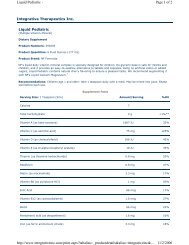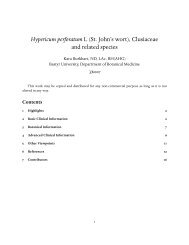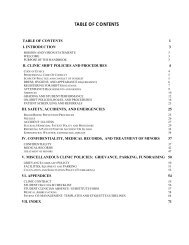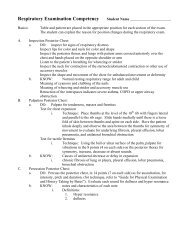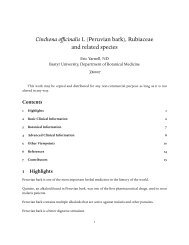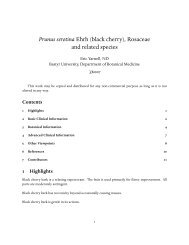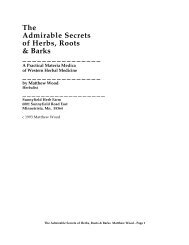FINAL ND Module 09-10.pdf - AaronsWorld.com
FINAL ND Module 09-10.pdf - AaronsWorld.com
FINAL ND Module 09-10.pdf - AaronsWorld.com
Create successful ePaper yourself
Turn your PDF publications into a flip-book with our unique Google optimized e-Paper software.
and ate at local restaurants and stands. I did not have access to bottled water, but I have an old<br />
filter I used to use when I went camping.) .<br />
It should include the attributes for every <strong>com</strong>plaint a patient presents with in the clinic. Ex: I have a<br />
stomach ache, a headache and diarrhea. My knee also hurts when I walk down stairs. These<br />
extra <strong>com</strong>plaints would be noted as Complaints #2, 3, and 4. If associated with the chief<br />
<strong>com</strong>plaint, example: diarrhea, it may be noted with all its attributes on the associated symptom<br />
portion of the related <strong>com</strong>plaint.<br />
b. It also includes the past medical history, family history, allergies, lifestyle, social history, current<br />
medications (correctly spelled), current supplement and over the counter drug use and a review<br />
of systems. Please see Bates for details regarding professional charting the patient history.<br />
2. Objective (O): This section includes the information you gather using your senses-what you see,<br />
hear, smell and feel while conducting a physical examination of the patient. It is <strong>com</strong>pleted using<br />
clinical language. Terms must be spelled correctly.<br />
3. Assessment (A): The assessment is one of the most important aspects of the chart. All active<br />
diagnoses, with a correct ICD-9 code for each, must be recorded in the assessment section. They<br />
must correspond with the diagnoses that are recorded on the superbill.<br />
Clinicians may consider their diagnosis likely but not certain, in which case they should precede<br />
the stated diagnosis with an indicative term such as “working” diagnosis, “presumptive” or<br />
“probable” diagnosis. In this event, the Assessment would also include rule/out(s) or a differential<br />
diagnosis. For example: “Probable Diagnosis: Atypical Migraine Headache, Rule/Out increased<br />
intra-ocular pressure.” Record your diagnostic rationale after each diagnosis or tentative diagnosis.<br />
Every rule/out diagnosis requires a corresponding action in the treatment plan. Differential<br />
diagnoses may or may not require action on the treatment plan. Finally, all active or resolved<br />
diagnoses and problems are recorded and tracked on the patient’s “health data sheet,” which<br />
appears on the left side of the front section of the patient’s chart. They are also included in the<br />
assessment section and noted as resolved.<br />
4. Problems: At BCNH, we follow a system that includes a problem list. It is described by Rakel<br />
in Essentials of Family Practice. A problem is defined as “anything that requires diagnosis or<br />
management or that interferes with quality of life as perceived by the patient. It is any physiologic,<br />
pathologic, psychological, or social item of concern to either the patient or the physician.” Rakel<br />
delineates further that a problem can be anatomic (hernia), physiologic (undiagnosed jaundice), a<br />
specific diagnosis, a sign, a symptom, economic (financial stress), social (family discord),<br />
psychiatric, a physical handicap, an abnormal lab or imaging finding, or a risk factor (personal or<br />
family). Note that “problem” is a more inclusive term than “diagnosis.”<br />
A diagnosis <strong>com</strong>municates the provider’s certainty of the existence of a specific disease entity. A<br />
problem can be a diagnosis, or it can be a variety of assessments in progress, some requiring<br />
further evaluation.<br />
a. If the purpose of the charted visit was to follow-up on a previously listed problem from a<br />
problem list, and the problem has resolved by inclusion in another diagnosis, or by cure or<br />
disappearance, this should be noted in your assessment<br />
b. Assessment: (Rationale or ddx)<br />
Diagnoses: GERD—Rationale: secondary to suspected food intolerance and possible weak<br />
sphincter muscle tone and reduced HCl/pepsin production<br />
Problems: headache—ddx: a typical migraine, chronic sinus infection, eyestrain<br />
5. Impression (I): After you indicate your active diagnoses and problems, you may then, give your<br />
impression of the patient. Remember to write this section professionally and respectfully. Nothing<br />
should be included in this section that you would not directly tell your patient. This includes the<br />
naturopathic diagnosis and the principles utilized in the case.<br />
6. Plan (P): All actions re<strong>com</strong>mended or prescribed at the present patient visit must be noted in the<br />
plan section of the patient’s chart. This will include instructions for diet or lifestyle modification or<br />
26



